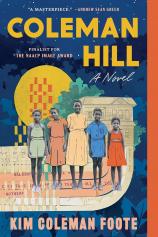Reading Group Guide
Discussion Questions
Coleman Hill

1. The author has called the book “a biomythography” --- a word coined by the late great writer Audre Lorde --- because it combines the author’s own family history with fiction. Why do you think the author chose to define her novel this way? What effect did it have on the reading experience?
2. COLEMAN HILL is written in the first-, second- and third-person at different points. How did the alternating points of views impact your connection to the characters? How did the author’s writing style contribute to your reading experience?
3. Which character did you sympathize with the most? Who did you have the most trouble with? Why?
4. In the book, different characters have different interpretations of pivotal family events. Why do you think this is done? What do you think it says about the way memory informs our understanding of ourselves and the world around us?
5. Which photograph or artifact in the book intrigued you the most and why?
6. The characters perceive their own and others’ skin color, hair, weight and other physical attributes in both positive and negative ways. How are their beauty standards impacted by mainstream culture like Hollywood movies?
7. In the book, women are expected to marry young, boys and men are expected to hold back tears, and children are expected to be quiet around adults. How do these and other expectations shape the characters’ lives? Which of these expectations are still prevalent today?
8. Explore the theme of generational trauma. What behavioral patterns are passed down in the book? How do they affect the younger generations?
9. The novel’s epigraphs are from Jacqueline Woodson’s BROWN GIRL DREAMING and Elizabeth Strout’s MY NAME IS LUCY BARTON. Talk about why the author might have chosen these two passages and how they relate to COLEMAN HILL.
Coleman Hill
- Publication Date: September 17, 2024
- Genres: Fiction, Historical Fiction, Women's Fiction
- Paperback: 336 pages
- Publisher: Zando – SJP Lit
- ISBN-10: 1638931704
- ISBN-13: 9781638931706







